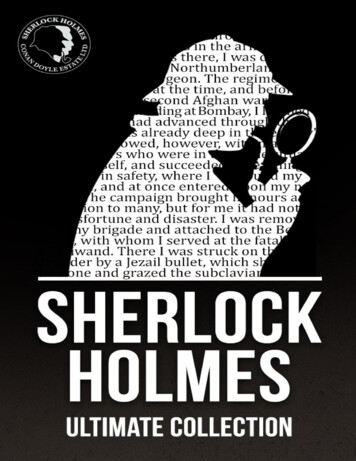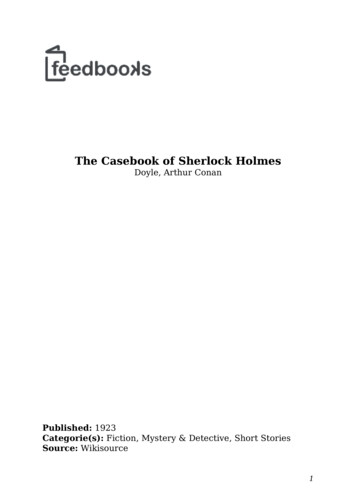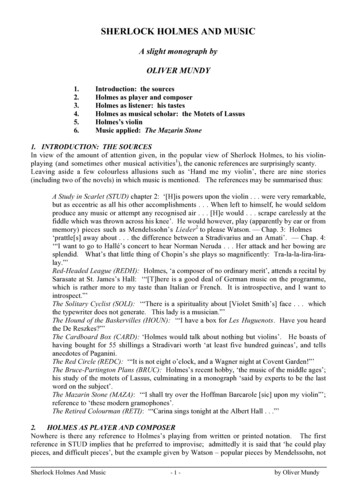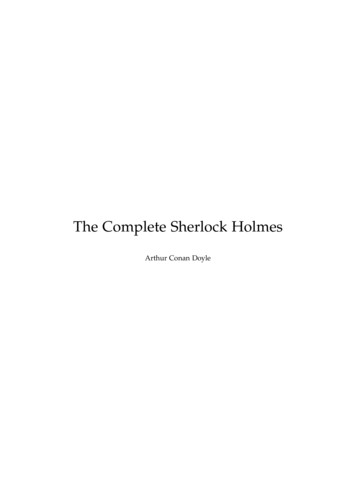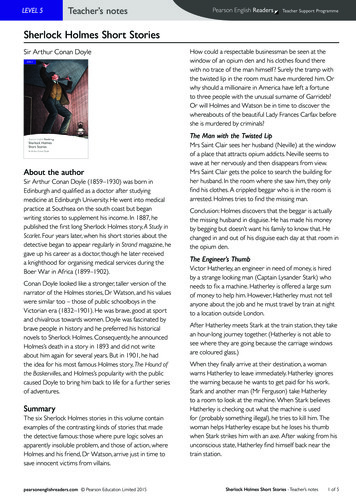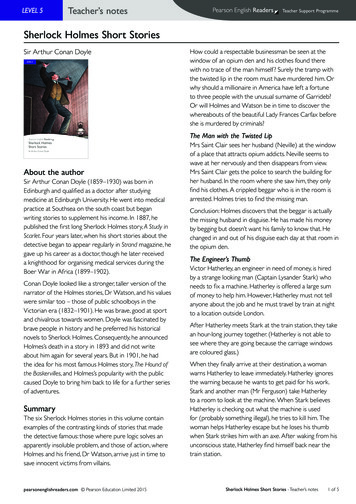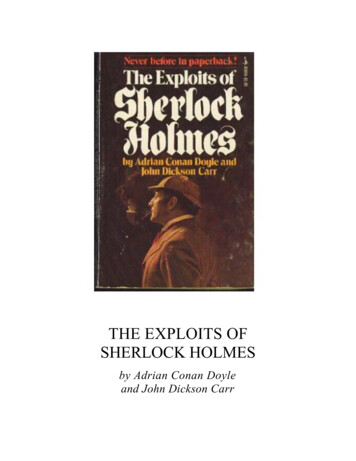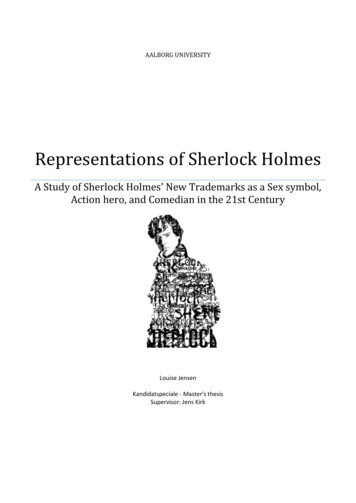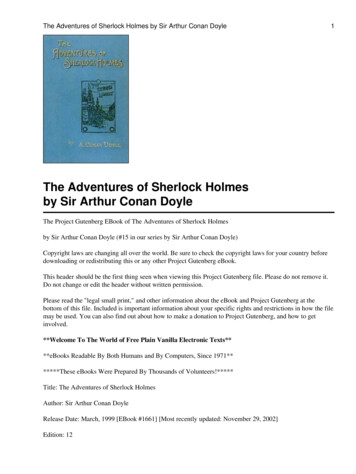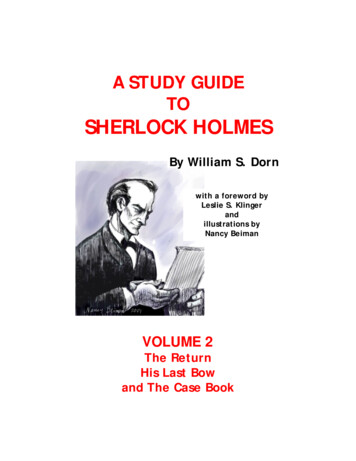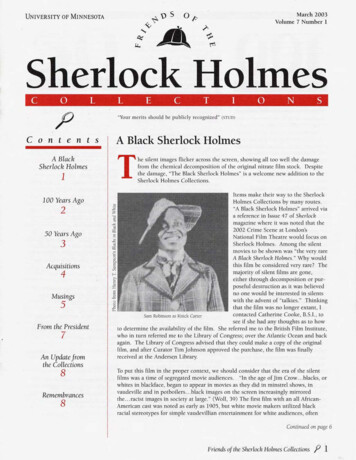
Transcription
March 2003Volume 7 Number 1Sherlock Holmes"Your merits should be publicly recognizedC o n t e n t sA BlackSherlock Holmes1100 Years Ago50 Years Ago3Acquisitions4Musings5From the President7An Updatefromthe Collections8Remembrances8(STUD)A Black Sherlock HolmesThe silent images flicker across the screen, showing all too well the damagefrom the chemical decomposition of the original nitrate film stock. Despitethe damage, "The Black Sherlock Holmes" is a welcome new addition to theSherlock Holmes Collections.I Items make their way to the SherlockHolmes Collections by many routes."A Black Sherlock Holmes" arrived viaa reference in Issue 47 of Sherlockmagazine where it was noted that the2002 Crime Scene at London'sNational Film Theatre would focus onSherlock Holmes. Among the silentmovies to be shown was "the very rareA Black Sherlock Holmes." Why wouldthis film be considered very rare? Themajority of silent films are gone,either through decomposition or purposeful destruction as it was believedno one would be interested in silentswith the advent of "talkies." Thinkingthat the film was no longer extant, IBcontactedCatherine Cooke, B.S.I., toSam Robinson as Knick Canersee if she had any thoughts as to howto determine the availability of the film. She referred me to the British Film Institute,who in turn referred me to the Library of Congress; over the Atlantic Ocean and backagain. The Library of Congress advised that they could make a copy of the originalfilm, and after Curator Tim Johnson approved the purchase, the film was finallyreceived at the Andersqn Library.To put this film in the proper context, we should consider that the era of the silentfilms was a time of segregated movie audiences. "In the age of Jim Crow.blacks, orwhites in blackface, began to appear in movies as they did in minstrel shows, invaudeville and in potboilers. .black images on the screen increasingly mirroredthe. .racist images in society at large." (Woll, 39) The first film with an all AfricanAmerican cast was noted as early as 1905, but white movie makers utilized blackracial stereotypes for simple vaudevillian entertainment for white audiences, oftenContinued on page 6Friends of the Sherlock Holmes CollectionsP1Q?
Y E A R SA G OFrederic Dannay and Manfred Lee,cousins who wrote together unclerthe pseudonym Ellery Queen, wrotein the introductory notes to TheMisadventures of Sherlock Holmes,that "the name Sherlock Holmes ispeculiarly susceptible to the twistingsand misshapenings of burlesqueminded authors."One early writer who was able totwist and misshape the nameSherlock Holmes was William L.Riordan who published two parodiesin the October 1903 Sunday magazine supplements of The New YorkTimes. John Bennett Shaw hadcopies of these two short articles inhis massive collection. (Editor's Note:Please see Musingsfor more infomation about how these articles foundtheir way to M1: Shaw.) The first to bepublished was "The Adventure ofPadlock Jones: The StolenDiamonds" which ran on October 11and the second, "The Adventure ofPadlock Jones: A Bedlamite" onOctober 25. They were reprinted inthe June, 1976 and September, 1976issues of the Baker Street Miscellanea.Riordan (1861-1909) was morefamiliar with Tammany Hall of NewYork than with Baker Street ofLondon. He was a newspaper journalist and "like so many newspapermen of the day, was fascinated byNew York City's endless variety ofcharacters." (Mann, viii) One character who particularly fascinatedRiordan was George WashingtonPlunkitt. Riordan wrote in his ownpreface to Plunkitt of Tammany Hall,that Plunkitt was "Tammany leaderof the Fifteenth Assembly District,2 f!Sachem of the Tammany Society andChairman of the ElectionsCommittee of Tammany Hall, whohas held the offices of State Senator,Assemblyman, Police Magistrate,County Supervisor and lderman,and who boasts of his record in filling four public offices in one yearand drawing salaries from three ofthem at thesame time." ( Riordan,xxiii) Plunkitt referred to a bootblack's stand in the old New YorkCounty Courthouse as his office andit was there that he gave talks onpolitics. Riordan published the textof these discussions in the New YorkSun, the New York Evening Post, theBoston Transcript, and the New YorkWorld, and saw them reprinted inpapers throughout the United States.He collected them into book form in1905 and described the volume as"the mental operations of perhapsthe most thoroughly practical politician of the day" (Riordan, xxiii)Among the numerous chapters werethose titled "Honest Graft andDishonest Graft, " "TammanyLeaders not Bookworms" and"Reciprocity in Patronage."Utilizing his knowledge of New Yorkpolitics, Riordan wrote "TheAdventure of Padlock Jones: ABedlamite." This short parody featured Padlock Jones and Dr. Jotsonin their quarters on CandlestickmakerStreet jn New York. A Brooklyniteseeks Jones's help after his son, "feeble-minded from boyhood," escapesfrom a sanitarium near Central Park.The cocaine-using Jones considersthe case, then proceeds to a politicalrally later that night. Accompaniedby Jotson and the unhappy father,Jones finds the boy amidst the crowdgathered to hear about "beet sugarand reciprocity." The next morning,when questioned about how heguessed the boy would be at therally, Jones responds with "Guess!Guess! Why will everybody, evenyou, Jotson, talk about my takingguesses?. .I never guess; I deduce."F r i e d of the Sherlock HolmesCoWectionsIn deducing where a young manwould go to seek entertainment,Jones stated ". it occurred to methat if there was one place in NewYork to which a feeble-minded person would go on a blood-chillingnight like this it was to an open-airmeeting."His other parody, "The StolenDiamonds" begins with "PadlockJones picked up the shoes which ourearly morning visitor had inadvertently left behind him." Stressingthat he never guesses, he deducesthat the owner of the shoes wasabsent-minded among other things,and that Jotson sees, but does notobserve. "Why, my deductions aresimplicity itself!" When the ownerreturns to gather his shoes he tellsthe duo he has been robbed of 3000worth of diamonds from his jewelrystore. The thief, Jones deduces, is ayoung woman employee led astray bya scamp and has taken the diamondsto finance her wedding to him. Theyoung woman was to be found at aclothing sale at Beagle's; "Is not thededuction plain? Would your youngwoman or any other young womanwith money miss that sale even if sherisked state prison by going to thestore?" The thief confesses and is letgo for the sake of her family.Riordan might be best rememberedfor his documentation of GeorgeWashington Plunkitt butSherlockians still enjoy his cleverparodies. He is, after all, as ArthurMann noted in his introduction tothe 1968 edition to Riordan's book,"Plunkitt's Boswell." vJulie McKurasReferences:Mann, Arthur. Introduction.Plunkitt of Tammany Hall.By William L. Riordan. New York:E. P. Dutton, 1963 edition.
THE GUILTY VICARAGEby W H. AudenThroughout his career, the AngloAmerican poet WH. Auden (19071973) produced a steady stream of journalism, writing on subjects as various asopera, Henry James, Kierkegaard, coldweather, Mozart, the moon landing, ballet and, not least, the detective story."The Guilty Vicarage" an analysis of theclassic English whodunit - firstappeared in 1948 in Harper's magazineand was later reprinted in Auden's 1962collection The Dyev's Hmd. [Editor'snote: John Bennett Shaw's collectioneditincluded the 1953 Modem Essays,*ed by Russel Nye. On the cover page isSbaw's w e d note "Much Holmesianreferencyin THE GUILTY VICARAGEpp. 400-412."] It is one of his bestknown essays, and one that any aficionado of the mystery should read.Auden's mind was categorical, and heliked nothing better than to creategrids, diagrams and definitions. Thoughhe confesses that for him "the readingof detective stories is an addiction," heanalyzes their appeal in the spirit of anAristotle systematizing Greek tragedy oran Aquinas dissecting some subtle theological question. The result is a series ofreflections presented like an outline.These are, as the original magazine article had it, "notes" on the nature of thewhodunit.For Auden the most satisfying detectivestories follow a set of rules as rigorousas the classical unities. One needs a"closed society" -a village, a university, a snowbound countryhouse -sothat the murderer isn't any random psycho just passing by What's more, thatsociety must be at first perceived asgood, innocent, in a state of grace. Themurder discloses that someone in thatEdenic world has fallen out of grace, sothat his or her identification by thedetective is necessary to allow therestoration of innocence to the GreatGood Place. By this definition, Audenexcludes much hard-boiled private eyefiction. The work of RaymondChandler, he maintains, offers a study ofthe criminal milieu and the PhilipMarlowe novels -which Auden judgespowerful but "depressing" - ought tobe judged not as escape fantasies but asworks of art. T h is, probably, theweakest section of Auden's essay: Idoubt that anyone regards The Big Sleepor Farewell, My Lovely as naturalisticstudies.As Auden proceeds, he grows bothincreasingly theological and Freudian inhis statements, even viewing the murderer as a Satanic rebel. Here, though,Auden makes a brilliant point: Anessential task for the writer of the mystery is to disguise the "demonic pride"of the killer both from the other characters and from the reader.As an act of "disruption," the murderleads to a tension between individualsand the law Each of the various suspects, he concludes, should be guilty ofsomething, even if not actual murder,The "principal causes of guilt" are thewish to kill, secrets such as "illicitamours," intellectual hubris (a feeling ofsuperiority to the actual investigatorthat leads to suspicious interference), akind of innocence that results in arefusal to aid the inquiry, and "a lack offaith in another loved suspect," whichcauses the well-intentioned friend tohide or confuse clues.After describing the job of the detectiveas the restoration of "the state of gracein which the aesthetic and the ethicalare as one," Auden points to threeexemplary figures: Arthur ConanDoyle's Sherlock Holmes, InspectorFrench (created by Freeman WillsCroft), and G.K. Chestenon's FatherBrown. In Holmes "scientific curiosityis raised to the status of a heroic passion." Holmes's reason for being a consulting detective is "a love for neutraltruth coupled with a need to escapehis "feelings of melancholy" InspectorFrench, whose adventures are notmuch read these days "detects for thesake of the innocent members of society," works from a devotion to duty, andrelies on other innocent people doingtheir own duties as postmen, clerks,and milkmen to break down seeminglyairtight time tables and alibis. FatherBrown's prime motivation is compassion, and he investigates murders inorder to save the souls of the sinners."He solves his cases, not by approaching them objectively like a scientist or apoliceman, but by subjectively imagining himself to be the murderer."In his last set of reflections Auden takesup the reader of mysteries, and theappeal of this form of "daydream literature." He provocatively asserts, albeitwithout a lot of evidence, that "Theidentification of fantasy is always anattempt to avoid one's own suffering:the identification of art is a sharing inthe suffering of another." So detectivestories allow us to assuage our humansense of guilt and sin by proffering "theillusion of being disassociated from themurderer." Auden ends by reemphasizing that the detective story addictindulges in "the fantasy of beingrestored to the Garden of Eden, to astate of innocence, where he may knowlove as love and not as the law The driving force behind this daydream is thefeeling of guilt."As powerful as Auden's argument is,some readers -including this one have long felt uneasy about his essay.First of all, Auden's definitions workbest, if at all, only for the "pure" classictale. He skips over what he would probably dismiss as the mystery's omamental elements - elements that other fanswould deem central: for instance,humor, style, atmosphere, the humaninteraction between the detective andhis Watson. He also undervalues theContinued on page 7Friends of the Sherlock Holrnes CollectionsP3
AcquisitionsThe Sherlock HolmesCollections now has twocopies of The NorwegianExplorers Christmas Annual2002. d i t o ; o h Bergquistnpresented these to Curator Tim Johnson, onecopy with a red cover and the second, a variant, with a green cover.(Only three copies were printed'witha green cover.)Inspector of The Ribston-Pippins for 13years, forwarded copies of the entirerun of Footprints G Lens of the RibstonPippins. The monthly newsletter originated with the February, 1989 issue.Jill Fritz Torwarded a copy of On AirMagazine, the publication of SanDiego'sradio station, KPBS.- publicThis January 2003 issue features anadvertisement entitled "Holmes andthe Hound" and gives informationabout the ExxonMobil MasterpieceTheatre adaptation of f i e Hound ofthe Baskewilles.Francine Swift is pictured here at theB.S.I. Cocktail Party in January, whereshe took the opportunity to donate acopy of the play "Upstairs,Downstairs, All Around the Holmes:A Drama of Sherlock Holmes in 13Episodes" by Norman M. Davis andWayne B. Swift. The script indicates itwa; presented by The e CircledPlayers of the Red Circle ofWashington D. c.,1974-1978. Inaddition to the play itself, a brief history of the Red Circle Players as writ-35-ctPhll cornell's artwork fromThe Adventure of the Amencan Molm storiginal artwork that graces the cover,was doneThis private edition offor Christmas, 2002 and is inscribedby Mr. Koch. More recently receivedtenSwift isI be; 2 of this W Clark Russell story,I which is illustrated by Charles Doyle, Gustav Dore and E W Hayes, with anintroduction by Hugo- Koch.IJohn Bergquist, Don Hobbs and Richard SveumDon Hobbs, the Maniac Collector,donated a copy of one of his latestfindings in foreign language editionsof the Canon. While in New York injanuary, Don -gave Dick Sveum andJohn Bergquist the paper and electronic copy of the Inuit version ofThe Hound of the Bashewilles.Les Klinger- forwarded the manuscript material for his recently published The Return of Sherlock Holmes. %This is the fifth volume in TheSherlock Holmes Reference Library,which is published by Wessex Press. 2Hugo Koch has forwarded two packages recently The first contained hisionograph* heAdventure of theAmerican Violinist and Phil Cornell'sMary K. St. John, Assoc ateProfessorat the General College of theUniversity of i n n e i o t agave,Specialcollections and Rare o o k curatorsTimothy Johnson the February 1997Gourmet magazine which had an article "The Case of the VictorianDetective: On the Trail of SherlockHolmes" by Jo Durden-Smith.IJulie McKuras, Dan Stashower, and Regina Stinsonat the 2003 B.S.I. Dinner%---,Klcnara weum, rrancme n r r , anajonnJean Tretter, Collection Specialist for theTretter Collection at the Elmer L.Andersen Library, donated several magazines to the Holmes Collections. Amongthe periodicals were the October 2000American Philatelist featuring- the article"The Adventure of the Detective Stamp"by William R. Hanson; the September1997 Smithsonian with Tom Huntington's"The Man Who Believed in Fairies"; andthe November 1998 American Phikztelistwith the article "Victor Lynch, Forger"bv David Hammer.C. C. Williamsen has provided theCollections with a copy of SherlockHolmes and the Adventure oftheBeleaguered Cub Fan by John H. Watson,M. D. The title page states this book waswritten by Dr. Watson with help from C.C. Williamson. The book was publishedin 2001 by Chazcliffl Books.ARegina Stinson of Royal Oak,Michigan, who served as Chief4 P Friends of the Sherlock Holrnes Collectionsocqqulsr-.-
MusingsIhave the enviable task of welcoming another distinguishedwriter to this newsletter.Michael Dirda is a writer andsenior editor for The WashingtonPost Book World. He received the 1993Pulitzer Prize for criticism and is theauthor of Readings: Essays and LiteravyEntertainments and An Open Book:Coming of Age in the Heartland, to bepublished by Norton this fall. In 2002he was invested in the Baker StreetIrregulars as "Langdale Pike." Mr.Dirda gives us a fresh look at W H.Auden's essay on detective fiction inthe 50 Years Ago column.Our lead article was a collaborativeprocess in many ways, from the initialdiscovery of the film's existence, toobtaining it, to writing about it. Iwould like to thank Professor JohnWright for his assistance with this article. Prof. Wright is the Director ofGraduate Studies and AssociateProfessor in the African-American andAfrican Studies Department, andAssoc. Professor in the EnglishDepartment, at the University ofMinnesota. I had the great pleasure oftaking the course "African-AmericanCinema" from Prof Wright severalyears ago and knew he would be theperfect resource for this article.100 Years Ago focuses on two littleknown parodies by W L. Riordan.The stories were pasted into a notebook labeled "Before 1903" by JohnBennett Shaw but there is no indication as to how he came to have them.Sometimes the story of how Shawamassed his collection is as interestingas the item itself. Jon Lellenberg, reading the article before it went to press,sent me the following note about JohnBennett Shaw:The "50 Years Ago" item about theRiordan parodies from John BennettShaw's Collection took me back. Isent them to John some 30 yearsago. In 1972 I was determined tofind the missing Shylock Homes par-odies by John Kendrick Bangs, oneof which had appeared in the ElleryQueen "Misadventures of SherlockHolmes" (Fred Dannay no longerrecalled where he'd found it, and Ispent more Saturday mornings than Ican remember at the Library ofCongress going through tons of old1903 newspapers. 1 eventually foundthem in the New York Herald (moreof them than Fred had ever realizedhad been published), but in themeantime I'd also found a number ofother unknown Sherlock Holmesparodies, including these two byRiordan which had appeared in theTimes. Shaw was so magnetic both in the attractiveness of his personality and enthusiasm for thehobby, and in the way that he collected, in the way that SherlockHolmes material moved inhis direction irresistibly, like iron filings toward a magnet - h a t one ofthe greatest pleasures of especiallyyounger and newer Sherlockianssuch as I was at the time was to findsomething to send him ti-om thepast, however slight and ephemeralit might be, like those Riordan parodies, that he had never seen before.We drew delight from delighting himthat way I've just gone to my Shawcorrespondence file and find this in aletter dated September 27, 1972: "YesI did get the two unknown pastichesby Riordan - thanks for sendingthem via Saul [Cohen, who'd beenvisiting Washington - the beginning of another extremely valuablerelationship in my Irregular career].And they are interesting findsindeed. I am listing things thatshould go in the first de Waal supplement and I have more than 50 sofar.poor fellow, he tackled a taskindeed. He knows it."J. B. Post of Paoli, PA sent an emailregarding John Bergquist's article onJulian Wolff's The Sherlockian Atlas inthe last issue. Mr. Post noted that "twoof the maps in THE SHERLOCKIANATLAS were reproduced in (his) ANATLAS OF FANTASY (Mirage, 1973:Ballantine/Souvenir, 1979.)" TheSherlock Holmes Collections holdscopies of these books with JohnBennett Shaw's bookplate. KarenMurdock, a geographer by trade, alsowrote in to comment about Dr. Wolff'smaps, stating that they "are the moreremarkable when you consider thetechnology available (and unavailable)to him at the time he made hisSherlockian maps. .He lettered thosemaps with something called a 'Leroyset'. . .A Leroy lettering set is a difficultto-master mechanical device. In usingit, the mapmaker traces a letter on aplastic template with the point of a stylus pen, while the other end of the pen(which has a little ink reservoir) marksthat letter on the map. Using the Leroyset with any success requires a great dealof time and patience and the rock-steadyhand of a master diamond cutter."And so we begin our seventh year ofwriting this newsletter. I was invited toaccompany Norwegian Explorer BoardMember Gary Thaden (author of"Watson's Books" in The NorwegianExplorers Christmas Annual 2002) to hisdaughter's school on Feb. 25. The students of Emerson School inMinneapolis performed adaptations of"The Boscombe Valley Mystery" and"The Hound of the Baskervilles." Itwas such a pleasure to see the playsand to note the children so engaged inboth stories. Afterwards, Gary presented the play's director with a number ofbooks with Holmes stories to be givento the students. As 1 often have theopportunity to wander through theSherlock Holmes Collections, I don'tbelieve we're in any danger of runningout of material to cover in future issuesof this newsletter. And with the nextgeneration being introduced to Holmesand nurtured by teachers and parentslike Gary, I don't believe we'll run outof readers and writers in the yean tocome. vJulie McKuras, A.S.H., B.S.I.Friends of the Sherlock Holrnes CollectionsP5
The Black Sherlock Holmes. . Continued from Page".shamelessly [playing] on racehumor, with blacks as the butts ofjokes and pranks." (Woll, 40)Entrepreneurs looked to the newbusiness of movie making and the eraof race films began. acef films featured African-American casts andwere "aimed primarily at black audiences who had grown weary of the'good old darkeys' and dancing pickaninies of mainstream cinema andwho were outraged by the success ofD. W. Griffith's 'The Birth of aNation.' These audiences could betargeted in an economically efficientway because their viewing was primarily restricted to all-black theatres. ." (McMahan) The studiosproducing these films featured blackactors but were often owned by whiteentrepreneurs. As did producers ofmost movies of the day, the producersof race films looked to popular culture and literature for their films,including white sources.By 1910, black showman WilliamFoster and his Foster PhotoplayCompany began producing allAfrican-American cast shorts forblack audiences in Chicago, moreaccurately addressing black life whileadhering to the model of Hollywoodgenres. Other race picture companiesappeared, including the HistoricalFeature Film Company of Chicago in1915. It catered to both black andwhite audiences and produced 2-reelslapstick comedies which relied onracial stereotyping. Drawing criticismfor the racist images, which resultedin a boycott of their pictures, theyreorganized in 1917 as the EbonyFilm Corporation and opened officesat 608 S. Dearborn St. in Chicago.They had an indoor production studio on N. California Ave. in Chicagoand an outdoor facility at LakeWinnebago near Oshkosh,Wisconsin. Ebony was still whitecontrolled but the director of thecompany was an African-Americannamed L. J. Pollard.6The Ebony Film Corporation had a"stock company of 40 black actors, 26of whom were members of the GeorgeM. Lewis Stock Company" (Sampson,201) The George M. Lewis StockCompany of black vaudevillians andstage actors worked not only for Ebony,but also for the great black filmmakerand producer Oscar Micheaux, according to Professor John Wright of theAfrican-American and African StudiesDepartment at the University ofMinnesota. Among the members of thestock company were Sam Robinson,whose cousin was Bill "Bojangles"Robinson, Samuel Jacks, Yvonne Junior,Will Starks,Julia Wilson, Evon Skeeter,Walter Brogsdale, Robert Dupree, andFrank Pollard."A Black Sherlock Holmes," the firstproduction of the newly reorganizedEbony Film Cooporation, wasreleased in April, 1918 and distributed by the General Film Corporationof New York City. The plot focuseson Knick Carter, portrayed by SamRobinson, who believes he is a greatdetective. He and his assistantReuma Tism, portrayed by RudolphTatum, attempt to save a kidnappedyoung woman, Sheeza Sneeze, portrayed by Yvonne Junior. Knick eventually saves Sheeza, who is able tomarry her true love. The film wasdirected by R. G. Phillips and runs for12 minutes.The plot of the film was similar to"Spying the Spy," released the sameyear, in which Sam Robinson playsthe lead character of Sambo Sam, an"amateur spy hunter" (Sampson, 271)who tries to be a hero by catchingGerman spies. The movies were wellreceived by white audiences whoenjoyed the novelty of "colored players who have an original and inbornsense of humor all their own"(Sampson, 241), according to areview in the Exhibition Herald.Where this, and the other Ebony productions, failed was with black audiences and the black press who con-P Friends of the Sherlock Holmes Collectionssidered the productions humiliating.The plots weren't based on any realexperience, "but rather on whatwhites 'knew' about blacks based primarily on the literature of the Southand its stereotypes." (McMahon)Black readers had read the serializedpublication from 1907 to 1909 ofJohn Edward Bruce's "The BlackSleuth," "but the attitude toward theblack detective in Bruce's militantlyrace proud tale is worlds apart fromthat of Ebony Corps's minstrelsybased caricature," wrote ProfessorWright. Black audiences had alsobeen treated to the film representations such as the earnest detective inOscar Micheaux's "Within our Gates."The Ebony Film Corporation produced 21 films featuring their stockcompany but many of their releaseswere not booked into the black theatres. The black newspaper TheChicago Defender urged theatre owners not to book Ebony films becausethey caused "respectable ladies andgentlemen to blush with shame andhumiliation." (Sampson, 207) Thecompany went out of business in1919. With the acquisition of "TheBlack Sherlock Holmes," we have afilm which, while it may be objectionable in its characters stereotypicalbehavior, still serves to indicate thepopularity of the truly great detective,Sherlock Holmes. wJulie McKuras, A.S.H., B.S.I.References:McMahan, Alison. Race Pictures Before RaceCinema. Available n: mcmahanl.htmRichards, Larry. African-American FilmsThrough 1959. Jefferson, NC and London:McFarland and Co., Inc., 1998.Sampson, Henry T. Blacks in Black and White,A Source Book on Black Films.Metuchen, NJ and London:The Scarecrow Press, 1995.Woll, Allen L. and Randall M. Miller.Ethnic and Racial Images in American Filmand Television. New York and London:Garland Publishing, 1987.
From the PresidentThis issue starts our seventhyear of reporting about theSherlock HolmesCollections and the work ofthe Friends. As I look back at mycollection of the Friends NewslettersI can see that we have covered thehistory of the collections, new donations and gifts, and the exceptionalgenerosity of our friends.I am happy to report the completionof the cataloging project thanks to agift from the Hubbs Family withadditional funding from theUniversity Library and the HenchEndowment. We can now truly saythat we have access as well as preservation. The E. W. McDiarmidCuratorship fund has topped 40,000 with much more in pledges.We are still looking for new membersto join the Sigerson Society with agift or pledge of 10,000 to theCuratorship Endowment.Looking forward we can see a financial challenge looming. The State ofMinnesota is facing a major revenueshortfall and the University ofMinnesota has cut the Library budget. It appears that SpecialCollections will suffer cuts in bothacquisitions monies and staffing during the first round of cuts. Weexpect that a second round of cutsthat address the impending statedeficit will be deeper still.What else can you do? To cover theloss in acquisition allocation we hopethat authors will donate a copy ofevery new monograph so we do notneed to purchase-the book, and thatevery editor of a serial will considerdonating a subscription to theUniversity The Sherlock HolmesCollections has lost funding for BethBogle, the Library Assistant andCollection Specialist. This leavesCurator Tim Johnson with only student help to run Special Collectionsand Rare Books. We are counting onyou, the Friends of the SherlockHolmes Collections, to help now morethan ever to cover the fall in Statefunding. Money is always needed.As we consider how we can best continue to obtain new publications, Iwant to thank two special friends ofthe Sherlock Holmes Collections,Francine Swift and Don Hobbs, whomade special donations this year inNew York. It is with the generosity ofsuch donors that we can continue tocollect previously printed materials.The Friends OJthe Sherlock Holmes Collectionsis a quarterly newsletter published by theFriends of the Sherlock Holmes Collectionswhich seek to promote the activities, interests and needs of the Special Collectionsand Rare Books Department, University ofMinnesota Libraries.Mail editorial correspondence c/o:Julie McKuras13512 Granada Ave.Apple Valley, MN 55124952-431-1934952-431-5965 Faxmike9750@aol.comEditorial BoardJohn Bergquist, Timothy Johnson,Jon Lellenberg, Richard J. Sveum, M.D.Copyright 0 2003University of Minnesota LibraryThe University of Minnesota is an EqualOpportunity Educator and Employer.Please help it what ever way to can aswe try to make the Sherlock HolmesCollections the World Center for thestudy of Sherlock Holmes and relatedareas. a Richard J. Sveum, M.D., B.S.I.50 Years. Continued from Page 3appeal of the puzzle -not the whodone-it but the how-done-it - andhence fails to touch on the work of suchgiants as Agatha Christie, John DicksonCarr and Ellery Queen, all masters ofthis aspect of the mystery Above all,Auden misses one great psychologicalappeal of these stories: The gratificationin watching not innocence restored, butrather a complex, seemingly random oreven apparently supernatural tangle ofevents gradually given order and purpose. In our own lives we often feel ourselves the playthings of fate and thegods; but in the traditional mystery weare comforted by entering
Sherlock Holmes Collections. B Sam Robinson as Knick Caner I Items make their way to the Sherlock Holmes Collections by many routes. "A Black Sherlock Holmes" arrived via a reference in Issue 47 of Sherlock magazine where it was noted that the 2002 Crime Scene at London's National Film Theatre would focus on Sherlock Holmes. Among the silent
